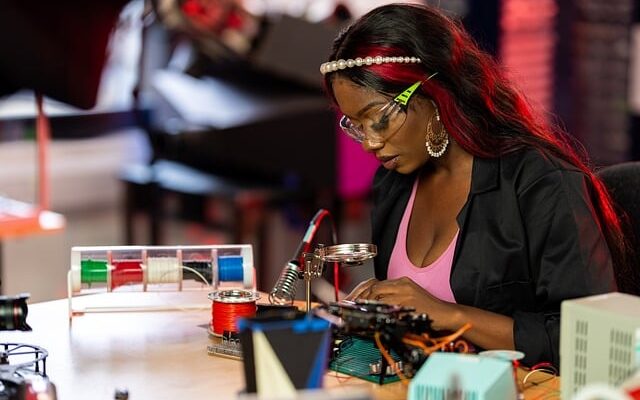In an era where technology has permeated nearly every aspect of our lives, fashion is no exception. The convergence of fashion and technology has given rise to a rapidly growing industry, referred to as “tech fashion.” This new wave of innovation isn’t just about aesthetics; it’s about creating garments and accessories that are functional, sustainable, and integrated into our digital lives. The evolution of modern tech fashion reflects society’s increasing need for practicality without sacrificing style.
In this article, we will explore the current trends in modern tech fashion, the rise of wearable technology, the influence of sustainability on tech fashion, and how minimalism is shaping the future of this dynamic industry.
1. The Rise of Wearable Technology
Wearable technology is one of the most prominent and tangible aspects of modern tech fashion. Devices like smartwatches, fitness trackers, and smart glasses are no longer niche gadgets reserved for tech enthusiasts. Instead, they have become essential accessories for the modern consumer, blending seamlessly into everyday fashion.
a. Smartwatches
Smartwatches have evolved from basic step counters into powerful tools that can track heart rates, monitor sleep patterns, and even offer smartphone-like functionalities such as notifications, voice assistants, and GPS tracking. Leading brands like Apple, Samsung, and Garmin have designed smartwatches that don’t just offer cutting-edge technology, but also come in sleek, customizable designs.
For instance, the Apple Watch allows users to swap between different bands, adjusting the look of the watch for any occasion. The versatility of these designs allows wearers to transition effortlessly from the gym to a business meeting. Meanwhile, brands like Withings have designed smartwatches that appear indistinguishable from traditional analog watches, offering the aesthetic appeal of classic wristwear with the intelligence of modern tech.
b. Smart Glasses
Smart glasses represent the next frontier in wearable technology. Google Glass was one of the first attempts at mainstreaming this product, but its initial reception was lukewarm. However, tech giants have not abandoned the idea, and recent advancements suggest a future where smart glasses become part of our daily wardrobe. Companies like Facebook, in collaboration with Ray-Ban, are pushing forward with stylish, fashion-forward glasses that incorporate AR (augmented reality) technology without appearing overly bulky or “techy.”
The fusion of functionality with subtle, high-fashion design marks a significant step in making wearable tech less about the tech and more about the wearability.
c. Fitness Trackers
The fitness tracker market, led by brands like Fitbit and Garmin, has grown exponentially over the past decade. These devices have shifted from purely utilitarian designs to sleek, aesthetically pleasing accessories. The emphasis now is on combining form with function. People no longer want just a tool to track their fitness; they want a fashionable statement piece.
Fitness trackers today feature interchangeable bands, color options, and elegant materials like leather and stainless steel, making them fit effortlessly into both casual and formal outfits.
2. Sustainable Tech Fashion
Sustainability is a major concern in both the tech and fashion industries, and modern tech fashion is no exception. As consumers become more conscious of the environmental impact of their purchasing decisions, fashion brands have been compelled to incorporate sustainable practices into their production processes. This trend is transforming tech fashion into a more eco-conscious industry.
a. Recycled Materials
Tech fashion brands are increasingly turning to recycled materials to create their products. For example, eco-friendly clothing companies are designing garments made from recycled plastic bottles, while some tech accessory brands create phone cases, laptop sleeves, and even sneakers from upcycled waste.
One prominent example is Adidas, which has collaborated with Parley for the Oceans to create sneakers made from ocean plastic. This collaboration has not only resulted in stylish and durable shoes but also raised awareness of the urgent need to protect our planet’s oceans from pollution.
b. Energy-Efficient Wearables
Beyond the use of recycled materials, energy efficiency is also becoming a priority in tech fashion. Many wearable tech devices, such as fitness trackers and smartwatches, are being designed to require less frequent charging. Solar-powered wearables are emerging as an eco-friendly alternative, reducing the dependency on disposable batteries or regular charging.
Additionally, brands are creating garments embedded with energy-efficient technology. For instance, clothing that can harness solar power to charge devices like phones or cameras is gaining traction. This not only offers convenience to the user but also aligns with the growing desire for eco-conscious products.
c. Ethical Production
Consumers today demand more transparency in how their tech fashion products are made. Ethical production, including fair labor practices and sustainable sourcing, is becoming a significant selling point for tech fashion brands. Companies like Patagonia, known for its eco-friendly approach to outdoor clothing, have been at the forefront of sustainable tech fashion, using recycled materials and ensuring fair labor practices across their supply chain.
3. Athleisure and Smart Fabrics
Another important trend in modern tech fashion is the rise of athleisure and smart fabrics. These innovations are changing the way we think about everyday clothing, merging comfort, style, and technology to meet the demands of a fast-paced, health-conscious world.
a. Athleisure
Athleisure, a fusion of athletic and leisurewear, has exploded in popularity over the past decade. What started as a fitness trend has become a lifestyle movement. People are increasingly looking for clothing that allows them to transition seamlessly from workouts to social events, without compromising on style or comfort.
Brands like Lululemon and Nike have led the charge, designing performance-driven pieces that look as good on the street as they do in the gym. Athleisure garments often feature moisture-wicking fabrics, anti-odor treatments, and built-in stretch for maximum comfort and functionality.
b. Smart Fabrics
Smart fabrics are taking athleisure to the next level by embedding technology directly into the fabric. These textiles can monitor body temperature, regulate moisture, and even change color based on environmental conditions. Imagine a jacket that adjusts its insulation levels based on the temperature or a shirt that tracks your heart rate during a run.
This type of technology has found applications beyond sports and fitness, as well. Fashion designers are increasingly using smart fabrics to create adaptive clothing for people with disabilities, ensuring that everyone can benefit from technological advancements in the fashion industry.
4. Minimalist Design in Tech Fashion
One of the hallmarks of modern tech fashion is the emphasis on minimalism. The design philosophy of “less is more” has become a central theme in both fashion and technology, as consumers gravitate toward clean, understated styles that prioritize functionality.
a. Streamlined Aesthetics
Minimalist tech fashion is characterized by neutral colors, sleek lines, and simple, elegant designs. This aesthetic allows wearable technology to blend into the wearer’s overall look, rather than standing out as a bulky, conspicuous device. The appeal of minimalist tech fashion lies in its ability to complement a wide variety of styles while maintaining a focus on practicality.
Take, for example, the sleek, barely-there design of the Apple AirPods. These wireless earbuds are designed to be unobtrusive yet highly functional. Their minimalist design has contributed to their popularity as both a fashion accessory and a piece of cutting-edge technology.
b. Versatile Functionality
Minimalist design in tech fashion is not just about appearance; it’s also about maximizing functionality. The goal is to create products that are simple to use and serve multiple purposes. For instance, minimalist smartwatches like the Withings ScanWatch look like traditional analog watches but are equipped with health-monitoring features, notifications, and fitness tracking.
Even in clothing, minimalist design can offer versatile functionality. A growing trend in tech fashion is the use of multifunctional garments, such as jackets with built-in phone chargers, retractable earphone holders, or water-resistant fabrics. These pieces combine fashion with utility, allowing users to simplify their lives without sacrificing style.
5. The Future of Tech Fashion
As technology continues to advance, the possibilities for tech fashion are virtually limitless. Innovations in areas such as artificial intelligence (AI), augmented reality (AR), and the Internet of Things (IoT) are likely to play a significant role in shaping the future of this industry.
a. AI-Driven Fashion
AI is already being used in fashion design to predict trends, optimize production, and create personalized recommendations for consumers. In the future, AI could enable entirely new forms of tech fashion, such as clothing that changes its design based on the wearer’s mood or environment.
b. Augmented Reality
AR has the potential to revolutionize tech fashion by allowing consumers to try on clothing virtually before making a purchase. This technology could reduce the need for physical fitting rooms and lead to a more efficient shopping experience.
c. The Internet of Things
The IoT, which connects devices through the internet, could further integrate technology into fashion. Imagine clothing that syncs with your smart home devices, allowing you to control your lights or thermostat through your jacket.
Conclusion
Modern tech fashion represents the perfect fusion of style and innovation. From wearable technology and smart fabrics to sustainable materials and minimalist design, the industry is rapidly evolving to meet the needs of today’s tech-savvy consumers. As technology continues to advance, the boundaries between fashion and functionality will blur even further, paving the way for a future where our clothes and accessories do more than just look good—they enhance our lives in ways we have yet to imagine.





